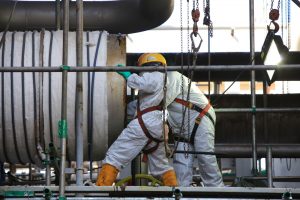Back to Basics is a weekly feature that highlights important but possibly overlooked information that any EHS professional should know. This week, we examine personal protective equipment (PPE) for emergency response and recovery workers.
Workers typically face many hazards that can be prevented or minimized through the use of engineering controls, administrative controls, and safe work practices, according to the Occupational Health and Safety Administration (OSHA). But when those controls are unable to reduce worker exposure to certain hazards to or below safe levels, employers must ensure workers are provided appropriate PPE at no cost and trained how to correctly use it.
PPE can include respiratory protection, protective clothing, and barriers used to protect workers from exposure to chemical (including oil), biological, radiological, and nuclear (CBRN) materials and other hazards, according to OSHA.
The types and levels of PPE will differ based on the specific hazard or hazards present. PPE also may be needed to protect against other hazards, such as electric shock hazards or hazards associated with exposures to hazardous substances that may be encountered during emergency response and recovery operations.
Employers with emergency response and recovery workers should take the following steps regarding PPE:
- Conduct a hazard assessment to determine what safety and health hazards workers may encounter
- Follow the hierarchy of controls—including elimination/substitution and engineering, work practice, and administrative controls—before relying on PPE to protect workers
- Determine what PPE workers need
- Provide the proper PPE to workers
- Train workers in the proper use of PPE, including how to put it on and take it off correctly, and how to clean, maintain, and dispose of it after or between uses
- Ensure that PPE is used properly and whenever necessary
- Provide medical exams and/or fit testing, as require by OSHA standards, prior to using certain types of PPE (e.g., respirators)
- Regularly review and update the PPE program as hazards change
Employers must plan in advance of an emergency for the PPE needs of their workers, since supplies may be limited during and immediately after an emergency. Make sure to train and fit-test workers for certain types of equipment before an emergency occurs.
Levels of PPE
Combinations or ensembles of PPE are classified generally into four levels, ranging from most protective (Level A) to the least (Level D). Each level of PPE consists of a combination of protective equipment and clothing that help reduce respiratory, eye, skin, and other types of exposures. Visit here for more information.
Other types of PPE may be added, including but not limited to eye protection, hearing protection, fall/falling object protection, high-visibility clothing, or U.S. Coast Guard-approved personal flotation devices, depending on anticipated hazards and specific worker tasks. OSHA’s PPE page provides information about PPE for various hazards across a range of industries, as well as links to relevant OSHA standards and other information.
Respiratory protection
If you have an operation that exposes workers to harmful levels of particulates, chemical vapors, biological agents, and other airborne contaminants, you’ll need to implement a comprehensive respiratory protection program that meets the requirements of OSHA’s Respiratory Protection standard. Respiratory protection may also be necessary if workers must pass through or may encounter toxic atmospheres (e.g., dust, mists, gases, vapors) or oxygen-deficient areas, including while conducting rescue operations and during evacuations. Respiratory protection programs require fit testing and training for workers, medical evaluation and monitoring, and selection of appropriate respirators (and cartridges, if required).
There are several categories of respiratory protection devices available to protect workers from inhalation hazards. These include:
- Self-contained breathing apparatus (SCBA): The highest level of respiratory protection, it is a full facepiece connected by a hose to a portable tank of compressed breathing air. Open-circuit, positive-pressure SCBA is the most common type.
- Supplied-air respirator (SAR): Facepiece connected to an air source away from the contaminated area via an airline. SARs have greater breathing air capacities than SCBAs, so they can be used for longer periods.
- Air-purifying respirator (APR): Facepiece worn over the face (full facepiece) or mouth and nose (half facepiece) with a cartridge or filter that removes specified contaminants from ambient air before inhalation. APRs do not protect against all air contaminates and must not be used where oxygen levels are inadequate.
For more information, see OSHA’s respiratory protection page. And for more about PPE, including PPE requirements in OSHA standards, see OSHA’s emergency preparedness PPE page.

